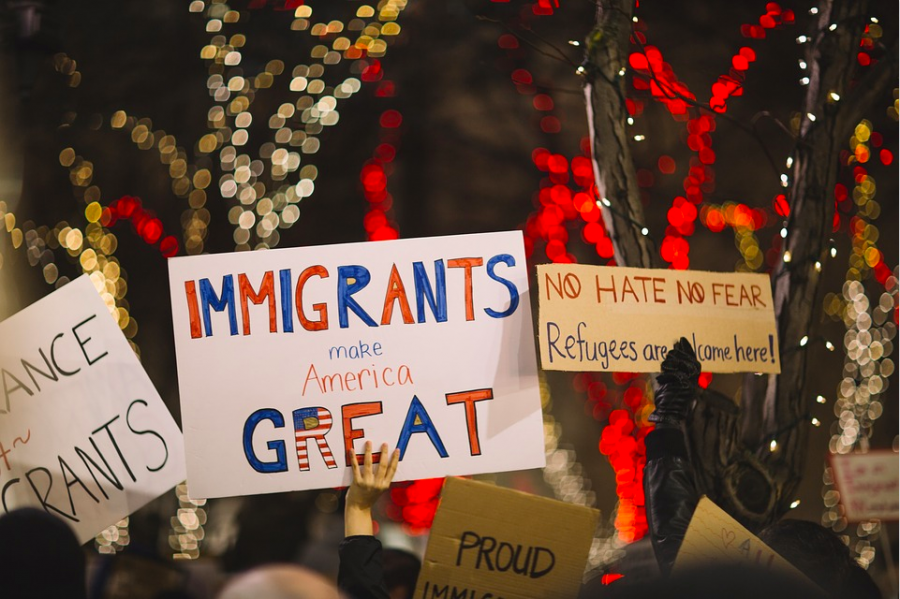Gravestones and Green Cards: Immigration in the United States
October 23, 2019
On May 10th, Yazmin Juárez walked out of New Jersey hospital, a sheet of paper clutched in her fingers. Twin handprints in pink paint decorated the surface — all she had left of her 19-month-old daughter, Mariee. Juárez left her home in Guatemala out of fear for her and Mariee’s lives, making the 1,500-mile journey across the US border, and was detained at an ICE facility in Dilley, Texas. They were locked in a cage and had to sleep on the concrete floor with over 25 other detainees. According to Juárez, the medical care at the various detention centers they were placed in was understaffed, crowded, and drastically irresponsible with the lives and well-being of both the adults and children in the center. Soon after they arrived, Mariee began experiencing a violent fever, coughing, vomiting, and diarrhea. Adequate medical care was not provided, and six weeks after being transferred to a hospital in New Jersey, though she was not in any condition to travel, Mariee Juárez died before her second birthday.
According to research conducted by the Cato Institute regarding Texas, in 2015 illegal immigrants are convicted of crimes 50% less than American-born citizens, and legal immigrants convicted 66% less. If immigrants are not driving up the crime rate, legal or illegal, why is there so much fear among Americans? Javier Ergueta, a teacher at Wilmington Friends and an immigrant from Bolivia in his childhood, says, “Recently, there’s been a resurgence of a mentality that was unexpected and rather shocking, that if you were naturalized, it turned out that the government was looking to actually undo naturalization, even going back decades. So, all of a sudden, [your] status is no longer the permanent status that you thought it was.” The Pew Research Center found that, as of 2017, the United States harbors one-fifth of the world’s immigrant population. 13.6% of the US is foreign-born. If so much of the country already are tax-paying immigrants, should the US be so hesitant to let more of them in?
Since October of 2018, the US Border Patrol has apprehended over 811,000 migrants on the Southwest border, 72,000 of those unaccompanied children, in addition to the 11 million illegal immigrants estimated by the Migration Policy Institute to already be living in the US. What could cause so many people to leave their homes to face the complicated US immigration system? Mr. Ergueta says that “some years of failed crops” and “radically changed environmental conditions” can cause many Latin American farmers and workers to flee. In addition to agricultural struggle, many face the threat of violence and seek safety for themselves and their families. According to the Washington Post, “Latin America is home to just 8 percent of the world’s population, but 33 percent of its homicides.” Surprisingly, however, the majority of Latin American immigrants come for work or education, with only a small percentage of refugees.
Without a doubt, immigrants cost the government. Social work and border control funding, education, and other services can take billions out of the national bank each year. However, economists agree President Donald Trump’s claim that illegal immigration was costing “250 billion dollars a year” was exaggerated and unfounded. In a 2016 study by the National Academy of Sciences, it was found that immigrants actually benefit the economy. Matthew Malone ’23 thinks that immigration in moderation is a wise investment for the US: “I do think they do good for some communities. They might do jobs that other people don’t want to do… in the long term, long run, the kids of immigrants will be more likely to get good jobs and help the government out.” Unidos US estimates that each immigrant, over their lifetime, will put ~$80,000 more into the United States government than the cost of services used, contributing to the 11.64 billion dollars undocumented immigrants pay in taxes every year.
The US is torn between solutions for what some are calling the “border crisis” of the time. Between President Trump’s border wall and numerous other proposals, those who fear people from other countries would harm our economy and those who would welcome them with open arms, the country cannot agree on a correct course of action for the situation. Much of the media coverage concerning foreigners are horror stories – terrorists in smoking cities, “thugs”, “animals”, “criminals”, and “rapists”. “It’s disrespectful, to be honest,” says Meenatchi Ganeshkumar ’21. “There are good people in this world… There are good immigrants out there, and you shouldn’t just discriminate because there have been immigrants that have been terrorists. I get the propaganda, but you shouldn’t always use the propaganda. You should be open-minded, in a way, because not everyone has an evil side. Everyone’s not born evil, if that makes sense. Or good.”































